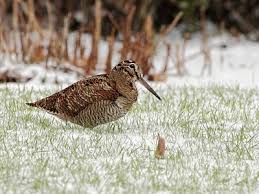Woodcock (Scolopax rusticola) is about 35cm in length, the largest in his kind in the Netherlands. The camouflage colors of the woodcock are effective: a speckled and mottled with rusty brown plumage with black and beige.
 The underside is light brown with horizontal stripes. He has a round head with prominent eyes far behind (360 degree view), and a very long, straight beak.
The underside is light brown with horizontal stripes. He has a round head with prominent eyes far behind (360 degree view), and a very long, straight beak.
The food of the woodcock consists of insects: worms, caterpillars, grasshoppers.
By only opening instead of the entire beak, only the tip of his beak he can catch worms deep in the ground. When rooting woodcock patters on earth likely as blackbirds and others to lure the worms up by this imitation of rain.
The migration of woodcock is very dependent on the weather and brings her also into marshes and moorland with rough scrub.
The breeding area is in Great Britain, Ireland, Northern Europe, Asia and Japan.
In the winter we se the woodcock in England and Ireland, Southern Europe, the Mediterranean Sea, and South Asia. In the Netherlands it is rare. In Belgium, it is a very rare bird.
He is protected except in Wallonia.
Woodcock leads into wooded areas a shy and quiet life. Until the last moment, he remains seated, and then suddenly shoots up and flies away in large hook patterns.
A male woodcock mates each season with about four females.
The nest is build on the ground in a forest with lots of undergrowth. It is usually at a bush or a tree trunk. It is a simple hole, covered with some moss. There are 4 eggs laid, cream-colored, with brown spots. The female incubates them in about 23 days.
The chicks are highly developed as they crawl out of the egg. They can quickly take care of themselves.
When the snipe (Gallinago Gallinago) with wide spread tail feathers is falling in a courtship flight the flapping of the tail feathers causes a sound that resembles bellow. With this he impresses females and male opponents. From there the common name ‘heaven goat’.
These 23 to 28 cm long snipe -likes have narrow light longitudinal stripes on the back and live along water shores where they look for worms and soil insects in shallow water and muddy puddles (soft soils) with their long straight beak.
They breed in our country and migrate from September. The nest is an undeep hole with grass stems and loose leaves. When in danger, he relies on his camouflage. The female lays between mid-March and mid-July 4 eggs, which hatch after 19 á 21. Only the female incubates. Male and female take care of the chickens, but each to their own group.
In Flanders, this protected bird is still rare.
